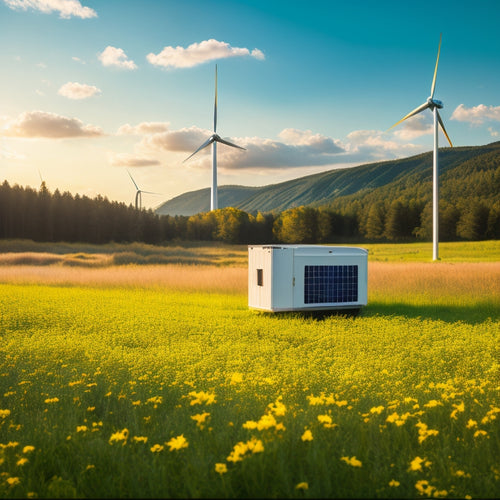
10 Tips for High Energy Homes
Share
By optimizing your roof's solar potential, evaluating energy usage patterns, and upgrading to energy-efficient appliances, you're already on your way to creating a high-energy home. Don't forget to tap into natural light, invest in energy-storage solutions, and maintain your solar system regularly. Selecting the right solar panel type and monitoring its performance are also essential steps. By implementing these strategies, you can greatly enhance your home's energy output and slash your utility bills. As you fine-tune your approach, you'll reveal even more opportunities to maximize your energy independence and minimize your environmental footprint - and there's still more to investigate.
Overview
- Maximize solar potential by optimizing roof orientation, pitch, and size for panel placement to increase energy yield by up to 20%.
- Regularly clean and inspect solar panels to ensure optimal energy absorption and prevent efficiency drops.
- Assess energy usage patterns to identify inefficiencies and pinpoint areas for improvement using smart plugs or monitoring devices.
- Upgrade to energy-efficient appliances with Energy Star ratings to reduce utility bills and enhance overall energy efficiency.
- Insulate and seal air leaks to minimize thermal bridging and air infiltration, improving overall energy efficiency and comfort.
Maximize Your Roof's Solar Potential
Leverage the power of the sun by optimizing your roof's solar potential. When it comes to solar panel placement, you want to guarantee maximum energy collection.
Assess your roof's orientation, pitch, and size to determine the ideal spot for your panels. Avoid rooftop shading from trees, chimneys, or vents, as it can greatly reduce energy output. Consider trimming nearby trees or installing panels at an angle to minimize shading.
Additionally, confirm the mounting system is secure and reliable, as a faulty roof preparation can lead to panel damage or detachment. Proper placement can increase your energy yield by up to 20%.
Assess Your Energy Usage Patterns
You're probably aware of your daily energy consumption habits, but have you considered the hidden energy wasters that could be secretly draining your resources?
To get a clear depiction of your energy usage, start by tracking your daily energy consumption patterns, including the times of day you use the most energy. Conduct an energy audit to identify inefficiencies and monitor consumption using smart plugs or monitoring devices for accurate data.
Next, look for those sneaky energy wasters, like appliances on standby mode or inefficient lighting, that could be adding up to big losses over time.
Daily Energy Consumption
Tracking your daily energy consumption is essential to understanding where your energy is being used and identifying opportunities for reduction.
You can start by monitoring your energy habits and identifying patterns. Take note of when you use the most energy throughout the day, and what appliances or devices are contributing to that usage.
Conducting energy audits load profiling can help you gather data on energy consumption and appliance power ratings, allowing you to pinpoint areas for operational improvement.
Consumption tracking can be done using a smart plug or an energy monitoring system. These tools provide real-time data on your energy usage, helping you pinpoint areas for improvement.
Hidden Energy Wasters
Now that you've got a handle on your daily energy consumption, it's time to dig deeper and uncover the hidden energy wasters in your home.
Phantom loads from idle appliances, outdated wiring, and inefficient lighting are major culprits. Poor thermostat placement can also lead to energy waste.
Consider hiring a professional to conduct an energy audit to identify these issues. Don't overlook single pane windows, drafty doors, and unsealed ducts, which can let heat escape.
Your appliance habits, such as leaving them on standby, can also add up. Be aware of energy vampires like phone chargers and TVs that continue to draw power even when turned off.
Optimize Your Home's Insulation
Proper insulation is an essential aspect of creating a high-energy home, as it helps reduce heat loss in the winter and heat gain in the summer. You can optimize your home's insulation by understanding thermal bridging, which occurs when heat escapes through gaps in the insulation. To minimize thermal bridging, choose the right insulation materials for your climate and budget.
| Insulation Material | R-Value |
|---|---|
| Fiberglass Batts | 2.9-3.8 per inch |
| Cellulose Insulation | 3.5-4.5 per inch |
| Spray Foam Insulation | 6-7 per inch |
Upgrade to Energy-Efficient Appliances
When you upgrade to energy-efficient appliances, you're not only reducing your carbon footprint, but you're also saving yourself some serious cash on utility bills.
By choosing appliances with the Energy Star rating, you can trust that you're getting a product that meets rigorous energy efficiency standards.
As you start to shop for new appliances, keep an eye out for ECO-friendly kitchen essentials that will help you create a more sustainable home.
Energy Star Ratings Matter
Your home's energy efficiency starts with the appliances you use every day. When shopping for new ones, look for the Energy Star rating.
This label indicates that the product meets energy efficiency standards set by the U.S. Environmental Protection Agency. Energy Star ratings matter because they help you make informed decisions about the appliances you buy.
You can trust that Energy Star-certified products will use considerably less energy and water than standard models. The rating system is based on strict guidelines, so you can be sure you're getting a high-performing, eco-friendly appliance.
Save Money on Bills
As you strive to create a more sustainable home, upgrading to energy-efficient appliances can considerably reduce your energy consumption, thereby slashing your utility bills.
By replacing traditional appliances with Energy Star-rated ones, you'll not only reduce your carbon footprint but also enjoy significant savings.
Consider investing in smart thermostats that learn your schedule and preferences to optimize energy usage. Conducting an energy audit can help you identify areas of inefficiency and prioritize upgrades.
Additionally, look for appliances with advanced features like sensor-controlled washing machines and refrigerators with high-efficiency compressors.
ECO-Friendly Kitchen Essentials
Step into your kitchen and take stock of the appliances that power your meal prep. It's time to upgrade to energy-efficient appliances and sustainable materials that align with your values of freedom and eco-friendliness.
| Appliance | Old Energy Consumption | New Energy Consumption |
|---|---|---|
| Refrigerator | 200 kWh/month | 100 kWh/month |
| Oven | 400 kWh/month | 200 kWh/month |
| Dishwasher | 300 kWh/month | 150 kWh/month |
| Microwave | 50 kWh/month | 25 kWh/month |
| Blender | 20 kWh/month | 10 kWh/month |
Invest in energy-efficient cookware, like ceramic or copper pots, which heat up faster and retain heat better than traditional materials. By making these swaps, you'll not only reduce your carbon footprint but also save money on your energy bills.
Harness Natural Light Effectively
Capturing daylight saves energy and uplifts your mood. By utilizing natural light effectively, you can reduce your reliance on artificial lighting and create a brighter, healthier living space.
Consider daylight harvesting techniques like installing light tubes or larger windows to bring in more natural light. Use window treatments that diffuse light, rather than block it, to maximize illumination.
Position furniture near reflective surfaces to bounce light deeper into the room. Orient rooms to take advantage of natural light, making seasonal adjustments as needed.
Choose light colors to reflect and diffuse light, reducing the need for artificial lighting.
Insulate and Seal Air Leaks
You've optimized your home's natural light, now it's time to tackle another key aspect of high energy homes: insulation and air sealing. Proper insulation and air sealing can greatly reduce energy consumption by minimizing thermal bridging and air infiltration.
| Area | Insulation Type | Air Sealing Method |
|---|---|---|
| Walls | Fiberglass batts | Caulk and spray foam |
| Ceiling | Radiant barrier | Weatherstripping |
| Floors | Rigid foam | Seal gaps with spray foam |
Invest in Energy-Storage Solutions
You're taking a significant step towards creating a high-energy home by considering energy-storage solutions.
By investing in battery backup systems, you'll guarantee a steady power supply during outages and reduce your reliance on non-renewable energy sources.
Additionally, integrating solar power and emergency power supply systems will further optimize your home's energy efficiency and sustainability.
Battery Backup Systems
Investing in a battery backup system can revolutionize your home's energy environment, providing a reliable safeguard against power outages and grid instability. With smart technology, you can seamlessly shift to renewable energy sources when the grid goes down. This means you can keep your lights on, your fridge running, and your family safe and comfortable.
| System | Capacity | Compatibility |
|---|---|---|
| Tesla Powerwall | 13.5 kWh | Compatible with solar and wind power |
| LG Chem RESU | 3.3-12.8 kWh | Works with various inverter brands |
| Sonnen eco | 2-16 kWh | Designed for off-grid and grid-tie systems |
| SimpliPhi Power | 2.7-3.9 kWh | Suitable for residential and commercial use |
| Rolls-Surrette | 2-4 kWh | Ideal for small to medium-sized homes |
Solar Power Integration
As the sun rises over your rooftop, its rays can be captured to power your home, reducing your reliance on the grid and slashing your energy bills.
By integrating solar power into your high energy home, you can take advantage of net metering benefits, renewable energy incentives, and community solar programs.
With various solar financing options available, you can install a grid-tied system, allowing you to generate your own electricity and sell excess back to the grid.
Regular solar panel maintenance guarantees peak performance.
Stay updated on solar technology advancements and residential solar trends to maximize your energy independence.
Consider off-grid living with photovoltaic system types customized to your needs.
Emergency Power Supply
While solar power integration provides a clean and renewable source of energy, it's not always available when you need it most - during power outages or emergencies.
That's where energy-storage solutions come in. Invest in a reliable emergency power supply to guarantee your home remains powered when the grid goes down.
Consider portable generators that can be fueled by renewable energy sources, providing a sustainable backup option. You'll enjoy the freedom to live life uninterrupted, even during outages.
Look for energy-storage solutions that integrate seamlessly with your existing solar power system, providing a comprehensive approach to your energy needs.
Select the Right Solar Panel Type
With the rise of renewable energy, you're likely contemplating solar power for your high energy home, and that means choosing the right solar panel type.
You'll want to evaluate solar panel materials, such as monocrystalline, polycrystalline, or thin-film, each with its own efficiency ratings.
Installation methods, like roof-mounted or ground-mounted, also impact performance.
Don't forget to reflect on monitoring systems that track your energy production and consumption.
Inverter types, like string inverters or microinverters, convert DC power to AC for your home.
Finally, consider the environmental impact of your chosen solar panel type, from manufacturing to end-of-life recycling.
Monitor and Adjust Your System
You've chosen the perfect solar panel type for your high energy home, but that's just the beginning.
Now it's time to guarantee your system is running at its best. System monitoring is essential to identify areas for improvement and optimize performance. You can use monitoring systems that provide real-time data on energy production, consumption, and storage.
This data will help you pinpoint issues and make performance adjustments. By tracking your energy usage patterns, you can adjust your system to meet your specific needs.
Make adjustments to your energy storage, panel tilt, and other system components to maximize energy production and reduce waste.
With continuous monitoring and adjustments, you'll be able to access the full potential of your solar system and enjoy the freedom that comes with renewable energy.
Maintain Your Solar System Regularly
Regular maintenance is essential to guarantee your solar system operates at peak performance and lasts for its entire lifespan.
You'll want to prioritize solar panel maintenance, which includes regular cleaning schedules to confirm ideal energy absorption. Inverter checks are also vital, as they can identify potential issues before they become major problems.
Performance monitoring allows you to track your system's efficiency and make adjustments as needed. Consider system upgrades to confirm your technology is current and running smoothly.
Don't forget to review your warranty considerations and troubleshooting tips to avoid costly repairs. Finally, schedule professional inspections to catch any issues before they impact your energy output.
Frequently Asked Questions
Can I Install Solar Panels on a Rented Property?
You can investigate solar panel options for your rented property, but first, review your rental agreements to confirm permission from your landlord; some may have restrictions or requirements for installations, so it's crucial to get their buy-in.
How Long Does a Typical Solar Panel Warranty Last?
"An ounce of prevention is worth a pound of cure" - you're wise to contemplate warranty coverage. Typically, you can expect a solar panel warranty to last 25 years or more, covering defects and ensuring a lengthy solar panel lifespan, giving you peace of mind for your investment.
Do Energy-Efficient Appliances Require Special Maintenance?
You'll be happy to know that energy-efficient appliances don't require special maintenance, but following simple tips can extend their lifespan; regular cleaning, gentle use, and updating software guarantee peak performance while preserving the planet's resources for future generations.
Can I Use Solar Energy to Power My Electric Vehicle?
You can utilize the power of solar charging to fuel your electric vehicle, ensuring a sustainable ride. Check your EV's compatibility with solar systems, then install a charging station that aligns with your vehicle's requirements, giving you freedom from fossil fuels.
Will Energy-Efficient Upgrades Increase My Home's Value?
You'll enhance your home's value by investing in energy-efficient upgrades, as a home appraisal will likely recognize these eco-friendly features, increasing your property's worth and appeal to environmentally conscious buyers seeking freedom from high energy bills.
Ready to Buy
As you flip the switch to a high-energy home, imagine utilizing the sun's fiery spirit to power your daily life. With these 10 tips, you're not just reducing your carbon footprint, you're blazing a trail towards a sustainable future. Your home will hum with efficiency, and the planet will thank you. Now, bask in the radiant glow of your eco-friendly abode, knowing you're lighting the way for a brighter tomorrow.
Related Posts
-

Smart Home Thermostats to Revolutionize Your Space
Smart home thermostats revolutionize your space by providing precise temperature control and optimizing energy saving...
-

Sustainable and Eco-Friendly Generators for a Reduced Carbon Footprint
Sustainable and eco-friendly generators are perfect for cutting your carbon footprint and increasing energy efficienc...
-

Essential Hiking Lights for Safety and Fun
When you're hitting the trails, essential hiking lights are vital for safety and fun. A lightweight headlamp offers h...


